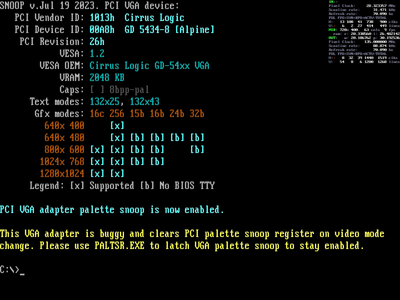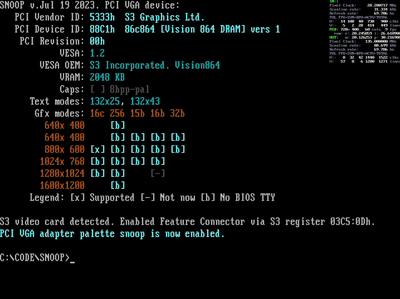dirkmirk wrote on 2024-01-03, 08:08:
I'm hoping to get good results hooking up a Gigabyte Auros F04U (48" OLED), is this the type of monitor something you guys had in consideration?
Gaming monitors are unfortunately not something that we've tested. So far testing has focused on older flat panels and some 1920x1200 displays (that we consider appealing for the 1600x1200 pixel perfect upscaling possibility). In my lab I have the following:
Fujitsu-Siemens P19-1 YEGA519530
Dell 2007WFP
Dell 2007FPB
ASUS ProArt PA248QV
Sony SDM-X73
BenQ BL3201PT
BenQ ET-0029-B
HP EliteDisplay E241i
Philips Brilliance 252B9/00
(of which Philips Brilliance 252B9/00 and ASUS ProArt PA248QV work the best, and they are 1920x1200)
dirkmirk wrote on 2024-01-03, 08:08:
I would be using cirrus logic CL5434 & S3 868 type of cards.
I have a Diamond Speedstar 64 1 MB PCI CL-GD5434 in my lab, which works nicely with CRT Terminator; except that there is a unique quirk in that card specifically that it forgets PCI bus palette snoop settings on every video mode change.
I wrote a TSR to fix that, which seems to work decently.
I don't seem to have a S3 868 card in my lab, the closest that I do is a S3 864:
Although I don't have a recollection of having put this card through much testing, so I'm not 100% sure how it fares. _Some_ S3 cards (might be just in the Trio line?) have a vendor/firmware-specific behavior that in order to get output from the Feature Connector, a S3-specific register must be enabled. SNOOP.EXE does that, and so can be placed in autoexec.bat, but it unfortunately means that on those cards there won't be any image during boot until that executes.
Iirc this is due to a hacky limitation of S3 (Trio?) they have that Feature Connector lines are shared with VRAM, or something like that.. so enabling the Feature Connector requires disabling half of the VRAM. (4MB -> 2MB maybe? I'm a bit hazy on the details when writing this right now)
dirkmirk wrote on 2024-01-03, 08:08:
When you state that 256 color mode is the initial target, is this device upgradable by firmware to improve support if required for higher resolution and color modes (i.e 800x600/1024x768 16 bit)?
It would be nice to play around with windows 95/98 at mid 90s targeted resolution and color depth.
I am afraid that this will likely not be possible.
CRT Terminator does have the option to upgrade the firmware after release, so we can mitigate problems after shipping.
However, the underlying reason here is that the Feature Connector is only a 8-bit data bus.
We observe that few rare VGA cards do output 16-bit and 24-bit color modes over the 8-bit bus by double and triple-clocking the video, which means the clock speed of the bus doubles or triples.
Some cards don't output 16-bit and 24-bit color modes via the 8-bit Feature Connector at all, but they just output the lowest 8 bits of the 16-bit video signal, and the highest 8 bits are discarded, making the hi/true-color output completely unusable. (yeah, spent some two and half weeks double and triple checking that to believe) I hunted for a possible VGA/RAMDAC register that might be able to change this behavior, but never was able to get any to work.
Some reverse-engineered notes about RAMDAC chips hint to the possibility of DDR signaling 16-bit modes over a 8-bit bus, but despite searching, we haven't been able to find and activate a single card/RAMDAC to do this. So there may be some future mysteries unsolved or to be debunked.
VESA standardized their later "VAFC" connector to run at max 37.5 MHz clock speed, which is essentially the same for this 8-bit Feature Connector bus. That speed is good for 800x600 @ 256 colors max.
In testing, some cards run a bit better, e.g. at 40-50MHz, but sadly not nearly as much better to be able to cope with the 2x or 3x pixel clock speed that would be required for 16-bit and 24-bit video modes.
So I recommend assuming that it won't be possible to get CRT Terminator to output new video modes after shipping, we want to be very cautious to avoid building up any disappointments in expectation.

